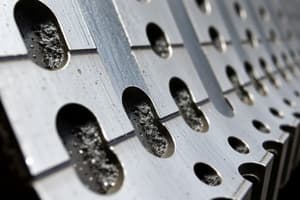Podcast
Questions and Answers
Which mechanical property refers to the extent of permanent or plastic deformation a material undergoes before fracture?
Which mechanical property refers to the extent of permanent or plastic deformation a material undergoes before fracture?
- Ductility (correct)
- Strength
- Elasticity
- Stiffness
What is the measure of a material's ability to restore to its original shape and size after the removal of external deforming loads?
What is the measure of a material's ability to restore to its original shape and size after the removal of external deforming loads?
- Hardness
- Toughness
- Elasticity (correct)
- Ductility
Which property denotes resistance to recoverable deformation?
Which property denotes resistance to recoverable deformation?
- Strength
- Toughness
- Elasticity (correct)
- Hardness
Which term describes the permanent deformation and/or failure of a component under fluctuating loads?
Which term describes the permanent deformation and/or failure of a component under fluctuating loads?
What does hardness measure in a material's mechanical properties?
What does hardness measure in a material's mechanical properties?
What is the splitting of a component into at least two halves called?
What is the splitting of a component into at least two halves called?
Flashcards are hidden until you start studying
Study Notes
Mechanical Properties of Materials
- Strength is the ability of a material to bear a load before fracture.
Ductility
- Ductility is the extent of permanent or plastic deformation that a material undergoes before fracture.
- There are two measures of ductility: percentage elongation and percentage reduction in area.
Elasticity
- Elasticity is the ability of a material to restore its original shape and size after removal of external deforming loads.
- Young's modulus is the measure of elasticity.
Stiffness
- Stiffness is the resistance to elastic (or recoverable) deformation.
Hardness
- Hardness is the resistance to plastic (or permanent) deformation, which includes indentation, scratching, or marking.
Toughness
- Toughness is the resistance to both elastic and plastic deformation.
Fatigue
- Fatigue is the permanent deformation and/or failure of a component when subjected to fluctuating (both in magnitude and direction) loads.
- Examples of fatigue include gear teeth, aircraft wings, and crankshaft of an automobile.
Fracture
- Fracture is the splitting of a component into at least two halves.
Creep
- Creep is the permanent deformation and/or failure of a component when subjected to high stresses at high temperature.
- Example of creep includes turbine disk and blades.
Stress-Strain Relationships
- There are three types of static stresses to which materials can be subjected: tensile, compressive, and shear.
- Tensile stress tends to stretch the material, compressive stress tends to contract the material, and shear stress tends to cause adjacent portions of the material to slide against each other.
- A stress-strain curve is the basic relationship that describes mechanical properties for all three types of loading.
Studying That Suits You
Use AI to generate personalized quizzes and flashcards to suit your learning preferences.




